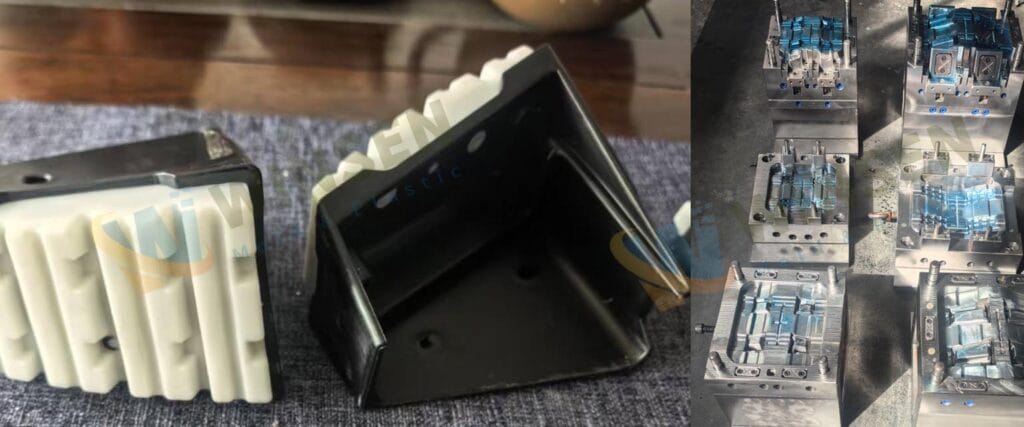What are the main design processes in injection mould ? Knowing the design process analysis of injection molds, and the design of which parts are included in a complete set of molds, today I will give you a detailed explanation:
Table of Contents
Toggle1. Composition of the gating system
Ordinary runner system (Runner System), also known as sprue system, or gating system, is the necessary passage for molten plastic from the nozzle of the injection machine (Nozzle) to the mold cavity. The runner system includes primary runner, sub-runner and gate.

What are the main design processes in injection mould
(1). Main channel
Also known as main sprue, sprue or vertical sprue, it refers to the runner from the part where the nozzle of the injection machine is in contact with the main runner bushing of the mold to the runner. This part is the first part the molten plastic flows through after entering the mold.
(2). Shunt channel
Also known as runner or secondary runner. With the mold design, it can be further divided into the first runner (First Runner) and the second runner (Secondary Runner). The runner is the transition area between the main runner and the gate, which can make the flow direction of the molten plastic change smoothly; for multi-cavity molds, it has the function of evenly distributing the plastic to each cavity.
(3). Gate
Also known as the feeding port, it is the narrow opening between the runner and the mold cavity, and it is also the shortest and thinnest part. Its function is to use the compressed flow surface to accelerate the plastic, and the high shear rate can make the plastic flow well (due to the shear thinning characteristics of the plastic); the heating effect of viscous heating also has the effect of increasing the material temperature and reducing the viscosity. effect.
After the molding is completed, the gate is the first to solidify and seal, which has the function of preventing plastic backflow and preventing the pressure of the mold cavity from dropping too fast, causing the molded product to shrink and sag. After molding, it is easy to cut off to separate the runner system and the plastic parts.
(4). Cold well
Also known as cold slug. The purpose is to store and replenish the cold plastic wave front in the initial stage of filling to prevent the cold material from directly entering the mold cavity, affecting the filling quality or blocking the gate. The cold slug well is usually set at the end of the main channel. When the length of the branch runner is long, the cold slug well should also be opened at the end.
2. Basic principles of gating system design
(1). Consideration of Cavity Layout
1) Try to use Balances Layout;
2) The arrangement of the mold cavity and the opening of the gate should be symmetrical to prevent the uneven force of the mold from causing eccentric load and the problem of mold overflow;
3) The cavity arrangement is as compact as possible to reduce the size of the mold.
(2). Considerations for Flow Guidance
1) It can smoothly guide the molten plastic to fill the mold cavity without generating eddy current, and it can be exhausted smoothly;
2) Try to avoid the frontal impact of plastic melt on cores and metal inserts with smaller diameters to prevent Core Shift or deformation.
(3). Consideration of heat loss and pressure drop
1) It is better if less heat loss and pressure drop;
2) The process should be short;
3) The cross-sectional area of the runner should be large enough;
4) Try to avoid the bending of the runner and the sudden change of the flow direction (change the direction at the arc angle);
5) The surface roughness need to be low when the runner is processed;
6) Multi-point pouring can reduce the injection pressure, but suture problems will occureds.
(4). Consideration of flow balance
1) When filling a mold with multiple cavities (Multi-Cavity), the runners should be balanced, and try to fill each cavity with plastic at the same time to ensure the consistency of the quality of the molded products in each cavity;
2) The runner should be arranged in a natural balanced layout (Naturally-Balanced Layout);
3) When the natural balance cannot be achieved, use the artificial balance method to balance the flow channel.
(5). Waste Considerations
On the premise of smooth filling without affecting the flow and pressure loss, reduce the volume of the flow channel (length or cross-sectional area) to reduce the waste generation and recycling costs of the flow channel.
(6). Consideration of cold material
Appropriate cold slug wells and overflow troughs are designed on the runner system to supplement the cold plastic wave front in the initial stage of filling and prevent the cold material from directly entering the mold cavity and affecting the filling quality.
(7). Exhaust Considerations
The plastic should be smoothly guided to fill the mold cavity, and the air in the mold cavity should be able to escape smoothly to avoid the problem of encapsulation burning.
(8). Consideration the quality of molded products
1) Avoid problems such as short shots, burrs, encapsulation, sutures, flow marks, jets, residual stress, warpage deformation, and mold core offset;
2) When the runner system has a long process or multiple gating, the warpage and deformation of the finished product due to unbalanced flow, insufficient pressure holding or uneven shrinkage should be prevented;
3) The appearance of the product is good, it is convenient to remove and trim the gate, and the gate mark (Gate Mark) does not damage the appearance and application of the plastic part.
(9). Production efficiency considerations
Minimize the post-processing so that the forming cycle shorten and improve production efficiency.
(10). Consideration of ejection points
Appropriate ejection position needs to be considered to avoid mold release deformation.
(11). Considerations for using plastics
For plastics with high viscosity or short L/t, avoid using too long or too small sized runners.

